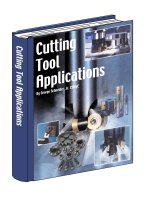Coatings Technology Handbook Episode 1 Part 4 ppt
Bạn đang xem bản rút gọn của tài liệu. Xem và tải ngay bản đầy đủ của tài liệu tại đây (507.65 KB, 11 trang )
9
-4
Coatings Technology Handbook, Third Edition
Colborn, Robert,
Modern Science and Technology
. Princeton, NJ: Van Nostrand, 1965.
Foreman, Jon, “Dynamic mechanical analysis of polymers,”
American Laboratory,
January 1997, p. 21.
Hassel, Robert L., “Evaluation of polymer flammability by thermal analysis,”
American Laboratory,
January
1997
.
Hassel, Robert L.,
Using Temperature to Control Quality,
Second Quarter 1991 P1 Quality. Hitchcock,
1991
.
Hassel, Robert L., “Thermomechanical analysis instrumentation for characterization of materials,”
Amer-
ican Laboratory,
January 1991.
Kelsey, Mark, et al., “Complete thermogravimetric analysis,”
American Laboratory,
January 1997, p. 17.
Neag, C. Michael,
Coatings Characterizations by Thermal Analyses
. ASTM Manual 17. West Consho-
hocken, PA: American Society for Testing and Materials, 1995.
Park, Chang-Hwan, et al., “Syntheses and characterizations of two component polyurethane flame retar-
dant coatings using 2,4dichlor modified polyester,”
J. Coat. Technol.,
December 1997, p. 21.
Reading, Micheal, et al., “Thermal analysis for the 21
st
century,”
American Laboratory,
January 1998, p. 13.
Riesen, Rudolf, “Maximum resolution in TGA by rate adjustment,”
American Laboratory,
January 1998,
p. 18.
TA Instruments Company, Thermal Analysis Application briefs available from TA Instruments Company,
New Castle, Delaware: TA-8A, Thermal Solutions — Long Term Stability Testing of Printing Inks
by DSC; TA-73, A Review of DSC Kinetics Methods; TA-75, Decomposition Kinetics Using TGA;
TA-121, Oxidation Stability of Polyethylene Terephthalate; TA-123, Determination of Polymer
Crystallinity by DSC; TA-125, Estimation of Polymer Lifetime by TGA Decomposition Kinetics;
TA-134, Kinetics of Drying by TGA; and TA-135, Use of TGA to Distinguish Flame-Retardant
Polymers from Standard Polymers.
DK4036_book.fm Page 4 Monday, April 25, 2005 12:18 PM
© 2006 by Taylor & Francis Group, LLC
10
-1
10
Color Measurement for
the Coatings Industry
Color is the most important appearance of coatings for their formulation, application, or inspection.
Color is also the most subjective parameter to characterize visually, and characterization is often
attempted under uncontrolled conditions that result in poor color judgement. Proper viewing conditions
require controlled lighting in a viewing booth where the different types of light, such as simulated daylight,
tungsten, and fluorescent light sources, can be used for evaluation. Visual evaluation always requires a
physical standard for comparison because the “color memory” of the brain is quite poor without one,
but very good when two samples are compared beside each other. Even when proper viewing conditions
are used, it is often difficult to determine the direction and intensity of color difference between two
samples. This process requires a trained colorist to make the evaluation.
A more accurate and consistent approach to evaluate color difference is the use of a color measurement
instrument. The two types of instruments that can be used for this purpose are colorimeters and
spectrophotometers. A colorimeter uses optical filters to simulate the color response of the eye, and a
spectrophotometer breaks the visible spectrum into intervals that mathematically simulate the color
response of the eye. The advantage of using spectrophotometers to determine color difference is in their
accuracy, stability, and ability to simulate various light sources. Spectrophotometer cost and complexity
of operation are greatly reduced on new versions of the instruments.
There are three different technologies that are used in modern industrial spectrophotometers: inter-
ference filters, gratings, and light-emitting diodes (LEDs). Interference filters require a filter for each
wavelength measured and usually have 16 or 31 filters depending on the resolution required. Grating-
based instruments have diode arrays of 20 to 256 elements to provide higher resolution for applications
that require it. The advantage of interference filters is in their simplicity of operation and mechanical
ruggedness. However, they are difficult to make consistent and deteriorate over time. High-performance
instruments usually have gratings that give more resolution and better consistency, but they are usually
more expensive and complex to build and calibrate. A new market entrant for spectrophotometers is
based on LEDs of different illumination colors. Up to nine separate color LEDs are now available to cover
most of the visible spectrum. The instruments operate by illuminating one LED at a time while measuring
the reflected light. The advantage is that they can be made very small and cost less to manufacture. The
disadvantages are reduced accuracy and stability, but the technology is improving with the advent of
newer LEDs with better methods for compensation.
There are several different measurement geometries: sphere, 45/0, and multiangle. A sphere instrument
illuminates a sample from all directions and views the sample at near normal or perpendicular. The 45/
0 illuminates the sample at 45 degrees from all directions and views the sample normal. It is also possible
to illuminate at 0 and view at 45. The multiangle approach illuminates at multiple angles and views at
a fixed angle. It is also possible to illuminate at a fixed angle and view at multiple angles.
Harold Van Aken
GretagMacbeth
DK4036_book.fm Page 1 Monday, April 25, 2005 12:18 PM
© 2006 by Taylor & Francis Group, LLC
Bibliography 10-2
11
-1
11
The Use of X-ray
Fluorescence for Coat
Weight Determinations
11.1 Introduction
11-
1
11.2 Technique
11-
1
11.3 Method
11-
2
11.4 Accuracy
11-
3
11.5 Repeatability and Reproducibility
11-
3
11.6 Conclusion
11-
5
11.1 Introduction
The technique of elemental analysis by x-ray fluorescence (XRF) has been applied to the quality control
of coating weights at the plant level. Measurements by nonlaboratory personnel provide precise and rapid
analytical data on the amount and uniformity of the applied coating. XRF has proved to be an effective
means of determining silicone coating weights on paper and film, titanium dioxide loading in paper, and
silver on film.
11.2 Technique
XRF is a rapid, nondestructive, and comparative technique for the quantitative determination of elements
in a variety of matrices. XRF units come in a variety of packages; however, the type of unit most prevalent
in the coating industry is described in this chapter.
The XRF benchtop analyzer makes use of a low level radioisotope placed in close proximity to the
sample. The primary x-rays emitted from the excitation source strike the sample, and fluorescence of
secondary x-rays occurs. These secondary x-rays have specific energies that are characteristic of the
elements in the sample and are independent of chemical or physical state. These x-rays are detected in
a gas-filled counter that outputs a series of pulses, the amplitudes of which are proportional to the energy
of the incident radiation. The number of pulses from silicon x-rays, for example is proportional to the
silicone coat weight of the sample. Because the technique is nondestructive, the sample is reusable for
further analysis at any time.
To ensure optimum excitation, alternate radioisotopes may be necessary for different applications. For
silicone coatings and titanium dioxide in paper, an iron-55 (Fe-55) source is used. Fe-55 x-rays are soft
(low energy) and do not penetrate far into a sample. For silver on film, a more energetic americanum-
241 source has been used.
Wayne E. Mozer
Oxford Analytical, Inc.
DK4036_book.fm Page 1 Monday, April 25, 2005 12:18 PM
© 2006 by Taylor & Francis Group, LLC
11
-4
Coatings Technology Handbook, Third Edition
FIGURE 11.2
Differences in sensitivities in products from different suppliers of silicone.
FIGURE 11.3
Differences in paper backings.
X-Ray CPS
200
150
100
50
.25 .50 .75 1.00
Concentration g/m
2
Vendor A
Vendor B
Vendor C
X-Ray CPS
200
150
100
50
.25 .50 .75 1.00
Concentration g/m
2
DK4036_book.fm Page 4 Monday, April 25, 2005 12:18 PM
© 2006 by Taylor & Francis Group, LLC
12
-1
12
Sunlight, Ultraviolet,
and Accelerated
Weathering
12.1 Introduction
12-
1
12.2 Sunlight
12-
1
Va riability of Sunlight
12.3 Accelerated Light Sources Compared to Sunlight
12-
2
The Importance of Short-Wavelength Cutoff
12.4 Arc-Type Light Sources
12-
4
12.5 Fluorescent UV Lamps
12-
7
12.6 Conclusions
12-
9
Acknowledgments
12-
9
References
12-
10
12.1 Introduction
Sunlight is an important cause of damage to coatings. Short-wavelength ultraviolet (UV) light has long
been recognized as being responsible for most of this damage.
1
Accelerated weathering testers use a wide variety of light sources to simulate sunlight and the damage
that it causes. Comparative spectroradiometric measurements of sunlight and laboratory testers of various
types show a wide variety of UV spectra. These measurements highlight the advantages and disadvantages
of the commonly used accelerated light sources: enclosed carbon arc, sunshine carbon arc, xenon arc,
and fluorescent UV. The measurements suggest recommendations for the use of different light sources
for different applications.
12.2 Sunlight
The electromagnetic energy from sunlight is normally divided into ultraviolet light, visible light, and
Infrared energy (not shown) consists of wavelengths longer than the visible red wavelengths and starts
above 760 nanometers (nm). Visible light is defined as radiation between 400 and 760 nm. Ultraviolet
light consists of radiation below 400 nm. The International Commission of illumination (CIE) further
Patrick Brennan
Q-Panel Lab Products
Carol Fedor
Q-Panel Lab Products
DK4036_book.fm Page 1 Monday, April 25, 2005 12:18 PM
© 2006 by Taylor & Francis Group, LLC
Enclosed Carbon Arc (ASTM G 153) • Sunshine Carbon Arc
(Open Flame Carbon Arc: ASTM G 152) • Xenon Arc (ASTM
FS-40 Lamps (F40-UVB) (ASTM G 154) • UVB-313 Lamp
G 155)
(ASTM G 154) • UVA-340 Lamp (ASTM G 154)
infrared energy. Figure 12.1 shows the spectral energy distribution (SED) of noon midsummer sunlight.
Sunlight, Ultraviolet, and Accelerated Weathering
12
-3
of cycles, or the reproducibility of results. For simulations of direct sunlight, artificial light sources should
be compared to what we call the “solar maximum” condition: global, noon sunlight, on the summer
solstice, at normal incidence. The solar maximum is the most severe condition met in outdoor service,
and, as such, it controls which materials will fail. It is misleading to compare light sources against “average
optimum sunlight,” which is simply an average of the much less damaging March 21 and September 21
equinox readings. In this chapter, graphs labeled “sunlight” refer to the solar maximum: noon, global,
midsummer sunlight. Despite the inherent variability of solar UV, our measurements show surprisingly
little variation in the solar maximum at different locations. Figure 12.3 shows measurements of the solar
maximum at three widely varied locations.
FIGURE 12.2
Seasonal variation of sunlight UV.
FIGURE 12.3
Solar maximum at three locations.
400380360340320300280260
1.2
1.0
0.8
0.6
0.4
0.2
0.0
Wavelength (nm)
Irradiance (W/m
2
/nm)
December
June
March
Equinox
400380360340320300280260
1.2
1.0
0.8
0.6
0.4
0.2
0.0
Wavelength (nm)
Irradiance (W/m
2
/nm)
Kitt Peak 6/86
Cleveland 6/86
Miami 6/87
DK4036_book.fm Page 3 Monday, April 25, 2005 12:18 PM
© 2006 by Taylor & Francis Group, LLC
12
-6
Coatings Technology Handbook, Third Edition
Another type of xenon arc filter that is intended to simulate sunlight through window glass is the Window
Glass Filter. It is typically used to test products with a primary service life that will be indoors. Figure 12.8
shows the SPD of noon summer sunlight behind glass compared to a xenon arc with a Window Glass Filter.
12.4.3.2 Xenon Arc Moisture
The xenon arc uses a system of intermittent water spray to simulate the effects of rain and dew. The
water-spray cycle is especially useful for introducing thermal shock and mechanical erosion.
12.4.3.3 Effect of Irradiance Setting
Modern xenon arc models, including the Q-Sun, have a light monitoring system to compensate for the
inevitable light output decay due to lamp aging. The operator presets a desired level of irradiance or
brightness. As the light output drops off, the system compensates by increasing the wattage to the xenon
2
how these two irradiance settings compare to noon summer sunlight.
Several different sensors to measure and control irradiance are available (depending on the manufac-
turer): 340 nm, 420 nm, TUV (total ultraviolet), or total irradiance. The difference between these sensors
is the wavelength or wavelength band at which they control the irradiance, and the wavelength or
wavelength band to which they are calibrated (through a NIST-traceable calibration radiometer).
FIGURE 12.7
Xenon arc with Daylight Filter versus sunlight.
FIGURE 12.8
Xenon arc with Window Glass Filter versus sunlight through window glass.
400380360340320300280260
1.2
1.0
0.8
0.6
0.4
0.2
0.0
Wavelength (nm)
Irradiance (W/m
2
/nm)
Sunlight
Xenon with
Daylight Filter
400380360340320300280260
1.2
1.0
0.8
0.6
0.4
0.2
0.0
Wavelength (nm)
Irradiance (W/m
2
/nm)
Sunlight through
Glass
Xenon with
Window
Glass Filter
DK4036_book.fm Page 6 Monday, April 25, 2005 12:18 PM
© 2006 by Taylor & Francis Group, LLC
burner. The most common irradiance settings are 0.35 or 0.55 W/m /nm at 340 nm. Figure 12.9 shows
13
-1
13
Cure Monitoring:
Microdielectric
Techniques
13.1 The Dielectric Response
13-
1
13.2 Changes In Resistivity During Cure
13-
2
13.3 Summary
13-
5
Developments in the area of microelectronics now enable the fabrication of microdielectric sensors that
can analyze drying, curing, and diffusion phenomena in coatings.
1
Several types of microdielectric sensors
have evolved in the past few years, the most sensitive being based on interdigitated electrodes and field
effect transistors fabricated on a 3
×
5 mm silicon chip.
2
The chip sensor is housed in a polyamide package
13.1 The Dielectric Response
The dielectric response arises from mobile dipoles and ions within the material under test. As a coating
cures, the mobilities of dipoles and ions are drastically reduced, sometimes by as much as seven orders
of magnitude. Microdielectric sensors are sensitive enough to follow those changes and are therefore
useful for cure monitoring, cure analysis, and process control.
3
The dielectric response is typically expressed by the quantities of permittivity or dielectric constant
(E
′
) and loss factor (E
″
):
(13.1)
(13.2)
where (
E
4
–
E
u
)/(1 +
wt
2
) is the dipole term,
se
0
ω
is the conductivity term, and
E
′
= dielectric constant
E
″
= loss factors
s
= bulk ionic conductivity
e
0
= permittivity of free space (a constant)
′
=+
−
+
EE
EE
u
ru
1
2
ωτ
′′
=+
−
+
E
s
e
EE
ru
0
2
1
ω
ωτ
ωτ
David R. Day
Micromet Instruments, Inc.
DK4036_book.fm Page 1 Monday, April 25, 2005 12:18 PM
© 2006 by Taylor & Francis Group, LLC
Process Control through Dielectric Feedback • Process Control
References
13-5
through Dielectric–Thermal Feedback
and configured for ease of placement in various processing environments (Figure 13.1).
13
-4
Coatings Technology Handbook, Third Edition
1. Heat and hold at 250
°
F until a log resistivity of 7.0 is reached (allows for degassing while preventing
premature cure).
2. Hold log resistivity (viscosity) at 7.0 until 350
°
F is reached (allows for controlled curing and
prevents second viscosity minimum).
3. Hold at 350
°
F until the dielectric reaction rate is near zero (allows reaction to go to completion).
4. Cool and notify operator that cycle has been completed.
FIGURE 13.4
Ionic resistivity data and
T
g
during isothermal epoxy–amine cure.
FIGURE 13.5
Process control of epoxy graphite cure utilizing microdielectric feedback.
11.3
6.2
Log Resistivity
0
0
40
80
120
160
200
50 100 150 200 250 300
Glass Transition (C)
Time (min)
Log Ion Viscosity
13
12
11
10
9
8
7
6
5
Temperature (°F)
300
250
200
150
100
50
350
400
450
050100 150 200
Time (min)
Hold at 250°F
until
Ionvisc. = 7.0
Hold Ionvisc.
at 7.0 until
Temp. = 350°F
Hold at 350°F until
Slope = 0
Cool Down
1 & 10 Hz
1 K & 10 K Hz
Pressure
Signal
Issued
100 Hz
Temperature (°F)
Fiberite F-934
DK4036_book.fm Page 4 Monday, April 25, 2005 12:18 PM
© 2006 by Taylor & Francis Group, LLC
14
-1
14
Test Panels
14.1 Cold Rolled Steel Panels
14-
1
14.2 Aluminum Panels
14-
4
14.3 Zinc-Coated Steel Panels
14-
6
Surface Preparation
14.4 Handling and Storage of Test Panels
14-
7
Bibliography
14-
7
When performing coatings tests, it is important to make sure that problems with the metal substrate do
not skew the test results. Test standards exist for all sorts of coatings characteristics, including adhesion,
flexibility, corrosion resistance, and appearance. These standards establish test conditions designed to
control variables, which can influence test results. These variables include the method of application, the
film thickness, the cure method, and the test substrate.
In a controlled laboratory environment, the application method, film thickness, and cure method can
be controlled with some degree of precision. In many cases, it is not possible to exercise the same degree
of control over the test substrate. For this reason, coatings technicians use standardized test panels when
conducting critical tests. A standardized panel is produced from carefully specified material and is
prepared in a tightly controlled process designed to yield a consistent test surface that can be relied upon
to provide reproducible results from test to test and from batch to batch.
There are many different types of standardized test panels available. The requirements for these panels
have been described in both national and international standards. These include ISO 1514:
Paints and
Var nishes
—
Standard Panels for Testing
, ASTM D 609:
Standard Practice for Preparation of Cold-Rolled
Steel Panels for Testing Paint, Varnish, Conversion Coatings and Related Coating Products
, and ASTM D
2201:
Standard Practice for Preparation of Zinc Coated and Zinc Alloy Coated Steel Panels for Testing Paint
and Related Coating Products
. The following is a general description of the different types of test panels
included in these standards, along with a discussion of the primary applications and sources of variability
for each panel type.
14.1 Cold Rolled Steel Panels
There are a number of points to consider when preparing a specification for standardized cold rolled
steel test panels. The type of steel selected should be of a standard grade and quality. It is important that
the steel be widely available. SAE 1008 and 1010 are examples of suitable grades of steel for test panel
production. The steel used should also be free from rusting and staining. Standardizing on a particular
grade of steel helps to eliminate variability in the chemical composition that can influence the results of
some types of testing.
Douglas Grossman
Q-Panel Lab Products
Patrick Patton
Q-Panel Lab Products
DK4036_book.fm Page 1 Monday, April 25, 2005 12:18 PM
© 2006 by Taylor & Francis Group, LLC
Surface Profile • Surface Carbon • Surface Preparation •
Applications
Surface Finish • Pretreatment • Applications









